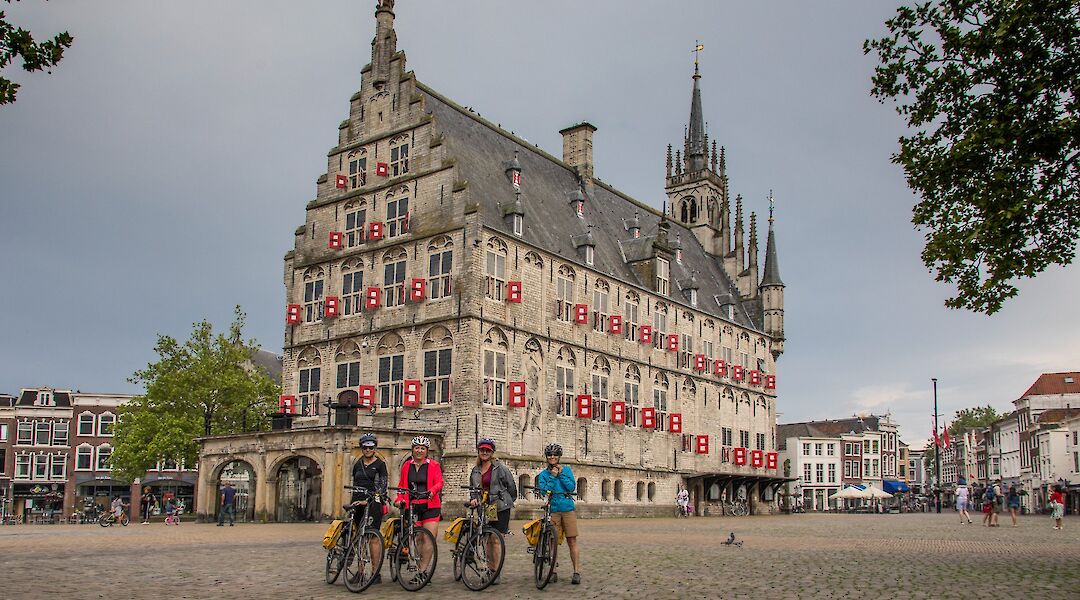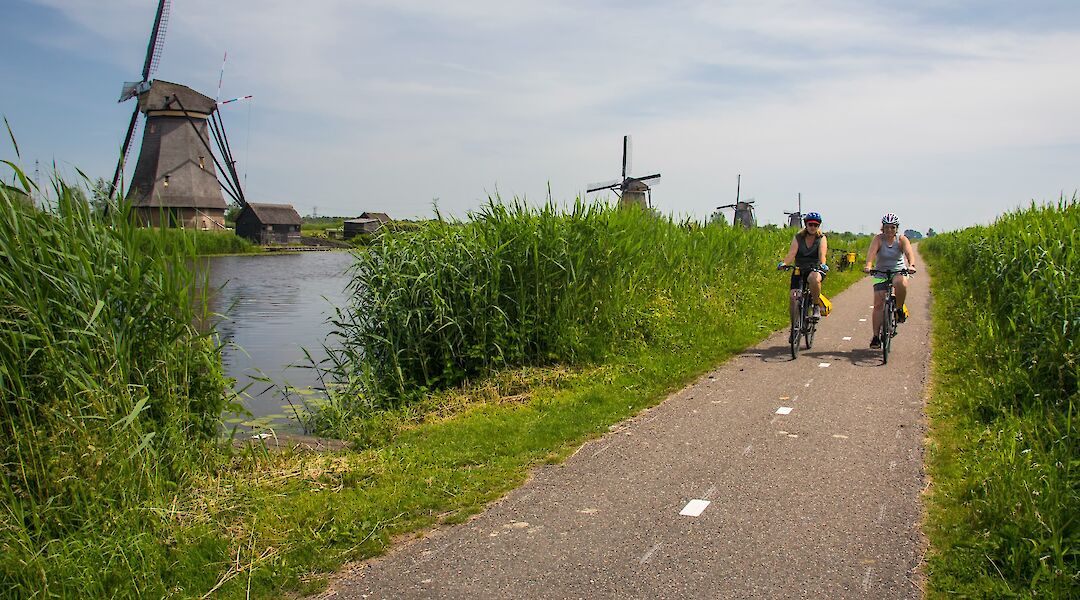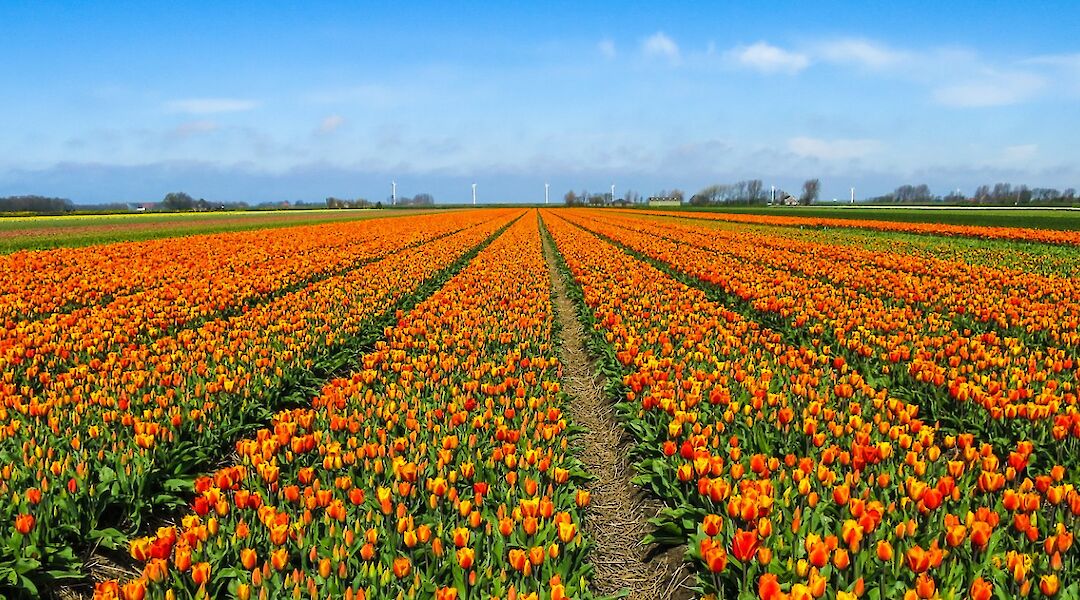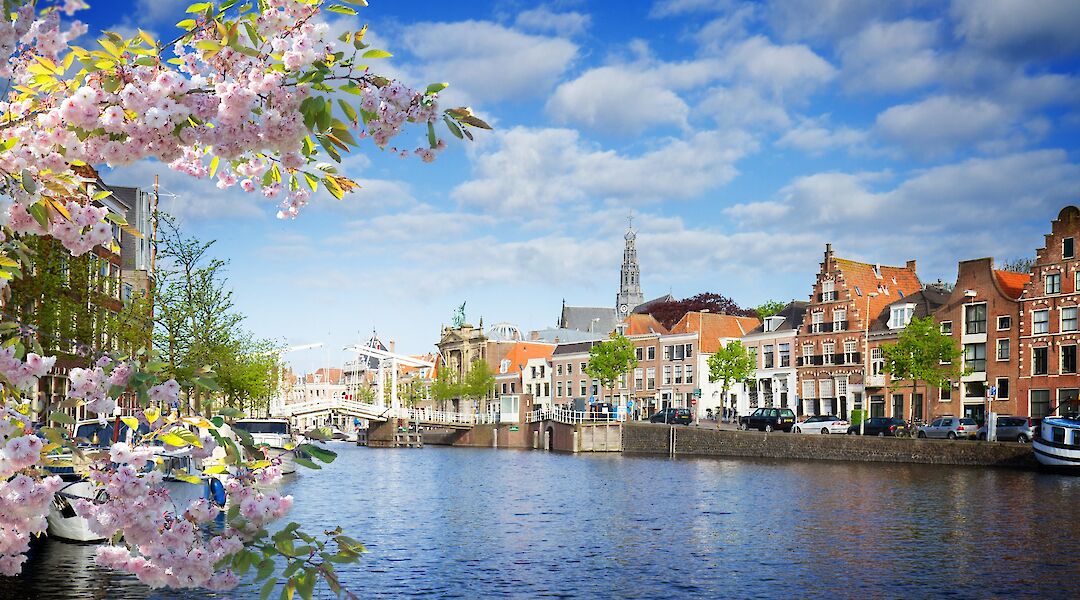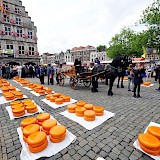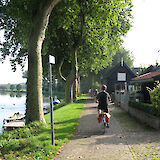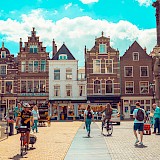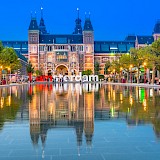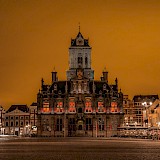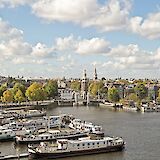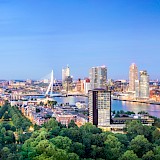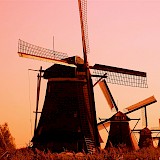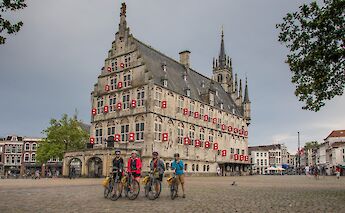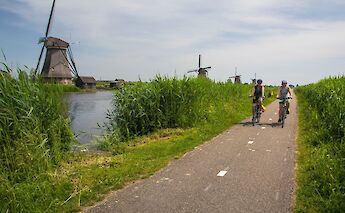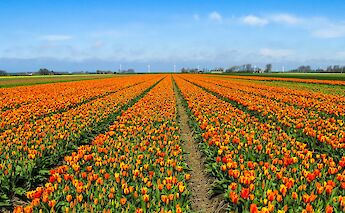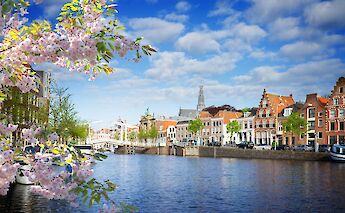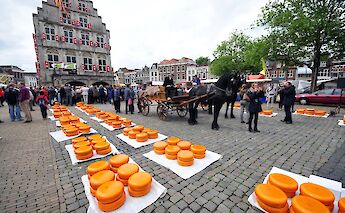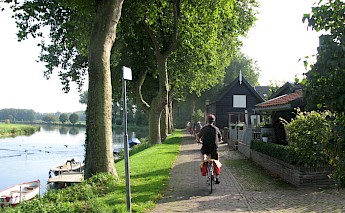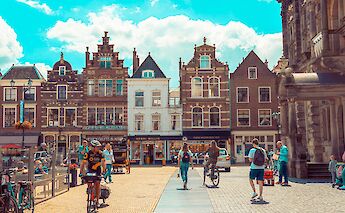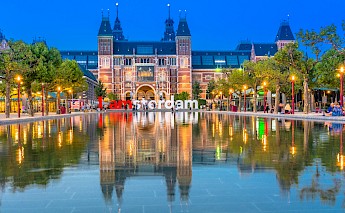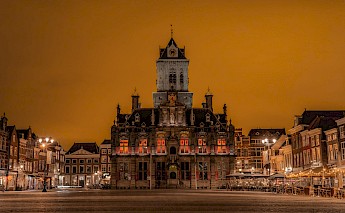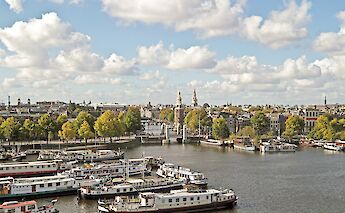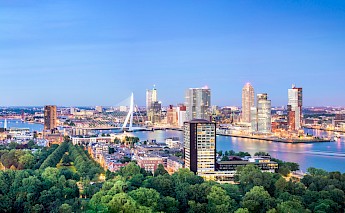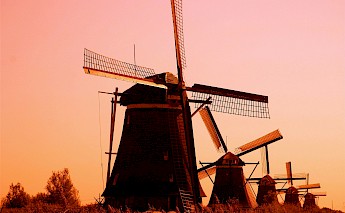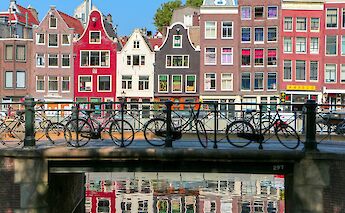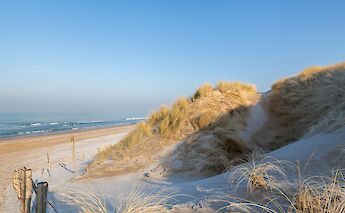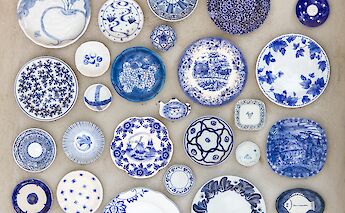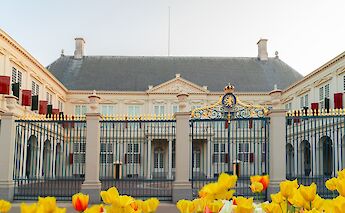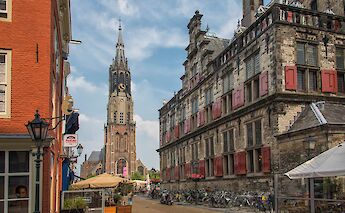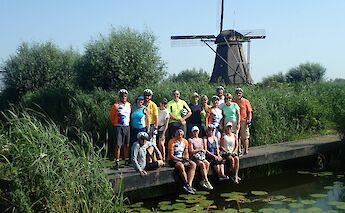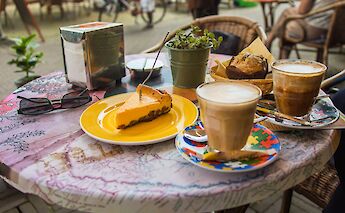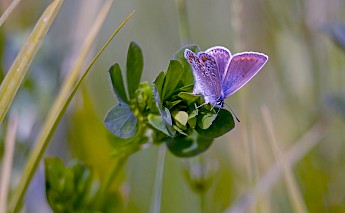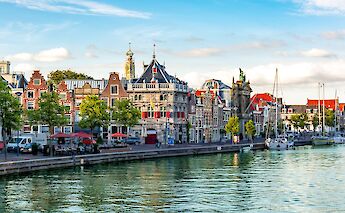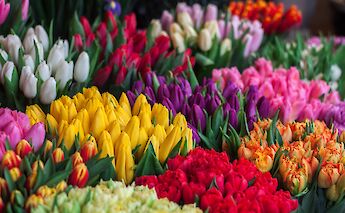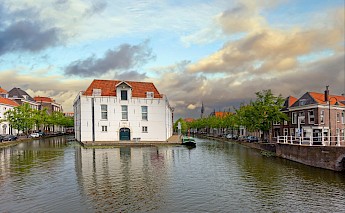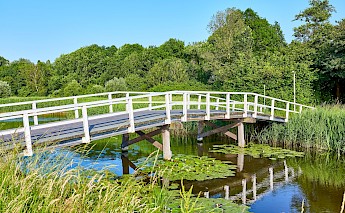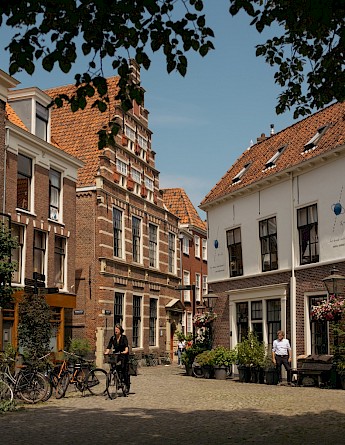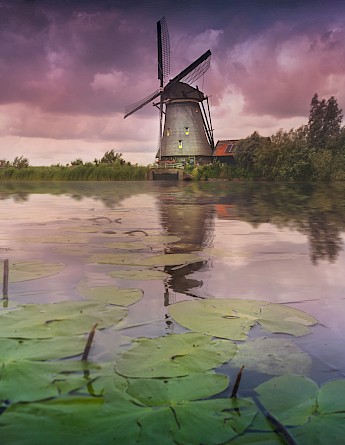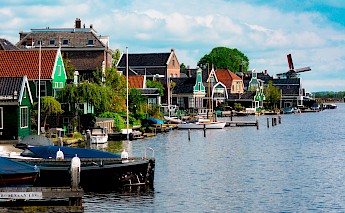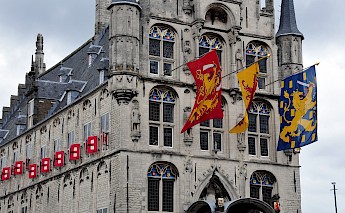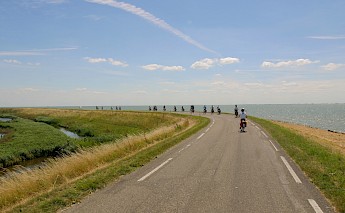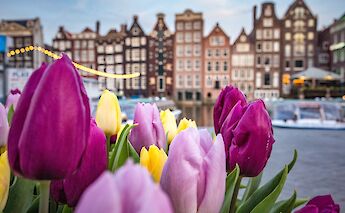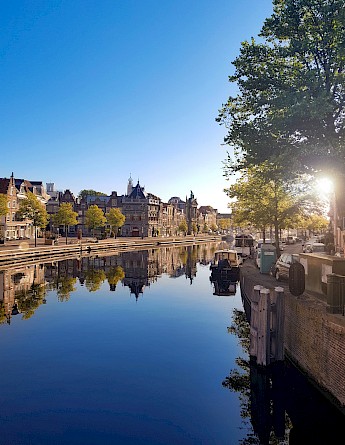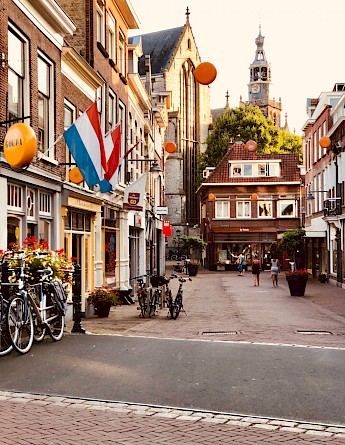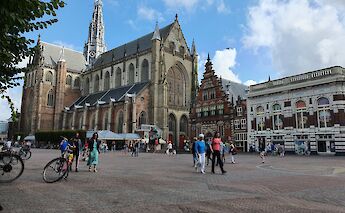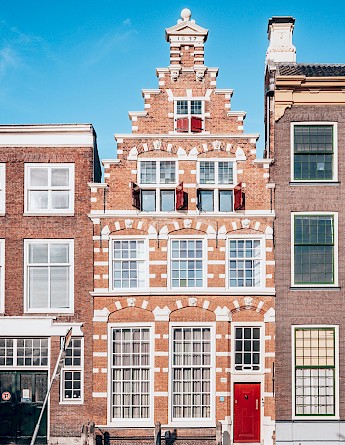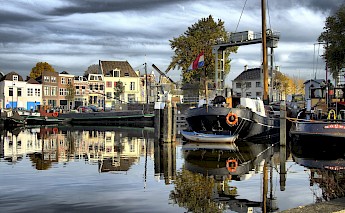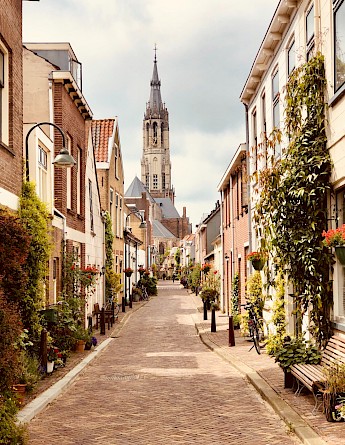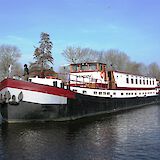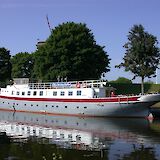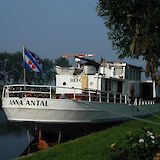Holland’s Southern Tour Bike and Barge
Guided from EUR € 999
Bike and Boat Tour aboard Wending, Liza Marleen or Anna Antal
Countries: Holland
Tap above to jump to different sections of this tour
-
Holland’s Southern Tour
Historic towns, picturesque villages, a rural environment abounding with water, dunes, and beaches: those are the typical ingredients of this Southern Holland tour. And let’s not forget the eighteen breathtaking windmills in Kinderdijk!
This varied trip guarantees a striking introduction to the green and cultural heart of Holland. One day you will be roaming the center of Haarlem, Leiden, or 16th Century Delft, the next you will cycle along the reedy borders of the Lek or Amstel river. In the historic towns there is time for visiting a museum (Frans Hals, Rembrandt, and Van Gogh), shopping, or relaxation in an outdoor café.
You will visit the beach and the dunes near The Hague by bike, just like many Dutch people. You will cruise through the world’s largest seaport, Rotterdam, by boat. Absolutely fantastic are the eighteen mills in Kinderdijk, driven by the wind and built around 1750. In 1997 they were put on the World Heritage List of the UNESCO. An optional canal tour by boat through Amsterdam will make this route complete.
Highlights
- Delft, the Hague, and Leiden
- Haarlem and Gouda
- Kinderdijk
Learn More
Learn more about guided tours.
-
Daily program
Day 1: Arrival and embarkation in Amsterdam; sailing to Spaarndam and cycle to Haarlem (9 miles/15 km)
The barge is moored at the Oosterdok in central Amsterdam, near the train station.You are expected to arrive at our barge on Thursday between 12:30 PM and 1:30 PM. When you arrive on board, you can settle in and enjoy a cup of coffee or tea. It is also a good moment to become acquainted with the tour leader, skipper and crew and of course your fellow passengers. The barge leaves the dock at 2:00 PM. You will first cruise through Amsterdam and over the North Sea Canal before reaching the village of Spaarndam. Here you can find the statue of Hansje Brinker on the IJdijk. Hansje is a character from an American novel. The brave boy saved the country from flooding by putting his finger in the dike.
From here we make an easy ride into the beautiful city of Haarlem and you will see the first of many windmills. During dinner aboard the ship, the program for the next day and the global planning of the week are discussed. Instructions on cycling and safely procedures will also be given. As on most days, after dinner the tour guide will take you on a walk through the city.
Overnight in SpaarndamDay 2: Haarlem – Leiden (28 miles/45 km)
Upon departure from Haarlem you will first cycle to the ‘Cruquiusgemaal’ (Cruquius Pumping Station): one of the three steam-powered pumping stations that drained the Haarlemmer Lake between 1849 and 1852. Now a museum, it gives you an excellent idea of the Dutch ‘battle against the water’. From this monument you ride towards the coast and into the dunes. On the way to the sea you will pass many beautiful country estates near Vogelenzang, and at lunchtime, you reach the seaside resort of Noordwijk.Over separate cycling lanes through more sanddunes and via the fishing village of Katwijk you reach the university city of Leiden. Do not foget to bring your swimming gear when the weather is fine. Leiden is a historic city with many little courtyards, façades, and historical buildings built between the 15th and 18th century. It also is the birthplace of the painter Rembrandt van Rijn. Leiden houses the oldest and most prestigious university of the Netherlands. All members of the royal family have studied here in the recent past. The right to found a university was given to Leiden after the city broke the Spanish siege in 1574. Still today this event is celebrated each year on the 3rd of October. The ship is moored near the Zijlpoort, a gate that once formed part of the city walls.
Overnight in LeidenDay 3: Leiden – Delft (25 miles/40 km)
You leave the city in a southerly direction and cycle along the Vliet canal. In Voorschoten you turn westwards towards the coastline and through some of the richest villages of the country like Wassenaar. At ‘Wassenaarse Slag’ is an entrance to the beach and here you can take a nice break. The beach stretches for miles on end on both sides. From here we cycle through extensive dunes to Den Haag (The Hague), where you can visit the Binnenhof with the houses of parliament, the royal palace Noordeinde and the Vredespaleis (Peace Palace).The route to Delft takes you along different waterways once again. The old centre is well worth a visit. This is a well-conserved medieval city with canals, a magnificent town hall and a royal tomb in the Nieuwe Kerk.
Overnight in DelftDay 4: Rest day: Delft
Today you can stay in Delft and discover the old centre or visit The Hague or Rotterdam by public transport. Delft is a beautiful town to wander round in, please visit the Oude and Nieuwe Kerk. Bustling Rotterdam has many architectural highlights, and some interesting museums and is the main port of Holland. Skyscrapers rise steadily towards the stars.On the Maas River, Erasmus Bridge is the new icon. Den Haag (The Hague) has an international character with its wide avenues, parks and stately mansions. Possible visits are a.o. Peace Palace (housing the International Court of Justice), the 'Binnenhof',seat of the Dutch Government and Parliament, royal palaces Noordeinde and Huis ten Bosch or the Mauritshuis museum with paintings by Vermeer, Rembrandt and Rubens.
Overnight in DelftDay 5: Delft – sailing to Rotterdam/Kinderdijk – cycling to Gouda (25 miles/40 km)
From Delft the barge first sails to Rotterdam where you board a fast ferry to Kinderdijk. Kinderdijk has a UNESCO cultural World Heritage listing and is the largest group of windmills in the Netherlands. The 19 windmills at Kinderdijk are an impressive sight and were still actively used until 1950. These days, a large pumping station is responsible for controlling the water level in the polder. Here you can visit a windmill from the inside. An impressive piece of centuries-old technique that is still functional today.`From Kinderdijk you will cycle over quiet countryroads and narrow cycling paths to Gouda. You ride past scenic polders and through the beautiful Alblasserwaard and the deepest lying polder of the Netherlands, Krimpenerwaard. Along the way you will pass green meadows with cows that produce the famous Gouda cheese. Who thinks of Gouda, not only thinks of cheese, pipes, ‘stroopwafels’ (treacle-waffle) and pottery, but also of stained-glass windows, a fairy-like town hall and atmospheric canals. Gouda is beautiful Old-Dutch city with a mostly intact city center.
Overnight in GoudaDay 6: Gouda – Oude Wetering (28 miles/45 km)
Before we continue on our way to Amsterdam a visit to the ‘St. Janskerk’ is in fact a must. Gouda’s 123-meter-long church is home to its renowned ‘Goudse Glazen’ (stained glass windows). You will also see the beautiful gothic town hall and the ‘Waag’ (a building once used for weighing cheese) before embarking on a ride through the Reeuwijkse Plassen, a nature reserve, and well-known wetland.Later this day you ride through again typical Dutch landscape filed with green meadows, wetlands, canals, rivers and small villages. You will cross waterways on small ferries and over bridges. Our last mooring place before Amsterdam is the quiet village of Oude Wetering.
Overnight in Oude WeteringDay 7: Oude Wetering – Amsterdam (28 miles/45 km)
Today you will first ride along different small waterways that lead you to the village of Uithoorn on the Amstel river. From here you will follow the Amstel river all the way to the mooring place of the barge. Along the way you will see several fortifications. They are part of De Stelling van Amsterdam, a 135 km long ring of fortifications around Amsterdam from 1885, and a UNESCO World Heritage site.Amsterdam's name derives from Amstelredamme, indicative of the city's origin as a dam of the river Amstel. Almost without noticing you enter Amsterdam, following the Amstel River. The extensive network of bicycle paths ensures a relatively easy way back into the city, showing you some remarkable sites in the centre. Then it is time to say goodbye to your bike.
Before the farewell dinner you may want to go for a walk in town. At night there you may want to take a canal trip or go on a city walk through the centre of the city
Overnight in AmsterdamDay 8: Amsterdam
End of the trip after breakfast (disembarkation by 10:00am).Surface and terrain
The tour follows a flat terrain route with only occasional hills.
Boats
How to get there
Tour start and end:
Nearest airport: Amsterdam Schiphol (AMS)
Nearest train station: Amsterdam Centraal StationThere is a train that leaves 6 times per hour from Schiphol Airport to Amsterdam Central Station. It takes about 16 minutes and costs approximately €5 per person one way.
A taxi from Schiphol to Amsterdam takes about 30 minutes. It costs about €35.
Tips on getting to and from your tour
-
Dates
Liza Marleen: May 09, 16, 23, 30; Jun 06; Jul 18; Aug 08, 29; Sep 05, 12; Oct 03, 2024.
Anna Antal: Jul 04, 11; Aug 01,15, 22
Wending: Jun 20, 2024.Low season: Jul 04, 2024 - Aug 15, 2024
Standard season: May 09, 2024 - Jun 27, 2024, Aug 15, 2024 - Sep 05, 2024, Oct 03, 2024 - Oct 10, 2024
High season: Sep 05, 2024 - Sep 19, 2024
Prices
Liza Marleen
Per person, double occupancy Low season Standard season High season Standard twin cabin €1280 €1430 €1570 Superior twin cabin €1500 €1660 €1800 Superior triple cabin (per person, triple occupancy) €1185 €1310 €1435 Single use cabin (1 person/1 cabin) €1865 €2070 €2285 Anna Antal
Per person, double occupancy Low season Standard season Standard twin cabin €1175 €1299 Bunk bed cabin €999 €1100 Single use, bunk bed cabin (1 person/1 cabin) €1275 €1425 Wending
Per person, double occupancy Standard season Standard twin cabin €1299 Triple cabin (per person, triple occupancy) €1215 Single use (1 person/1 cabin) €1660 Bike Rentals
Standard touring bike €110 Electrically assisted bike €220 Children's bike €60 Child's seat €15 Tag-along 55 Additional Options
Gluten free or vegan meals €75 Discounts
Child, ages 0-2 sharing a room with at least 1 full paying adult (on base package price) 100% Child, ages 3-11 sharing a room with at least 1 full paying adult (on base package price) 30% Included services
- 7 nights accommodation on board (including bed linens and towels)
- Breakfast and dinner on board
- Lunch packages when on the road
- Coffee and tea on board
- Tour guide, cycles with group
- At least 3 city walks with tour guide
- Free Wifi (limited available in lounge and on deck)
- Road book (1 per cabin)*
- Ferry fares on the route
- GPS tracks are available (upon request)
*The road book (1 per cabin) includes the detailed itinerary. Although the tour is guided, if you wish to cycle any of the days on your own, you may request the GPS tracks to assist you with navigation.
Bike rentals
Bikes available to be rented (booked in advance at the time of booking) include:
- Standard touring bike, 24-speed
- Electrically assisted bike, 24-speed, detachable lithium-Ion battery, unisex*
- Children's bike, child seats (rear of bike), trailer bike (one-wheeled bicycle attached to adult standard bike), bike trailer
- Bike insurance included with bike rental
*More about electrically-assisted bikes >
All above bike rentals will be equipped with the following at no additional charge:
- Helmet
- Pannier bag
- Lock
- Water bottle
- Repair kit (when cycling self-guided)
Pedals:
The bikes will have flat pedals. If you want to bring your own pedals, please bring your own shoes and also the necessary equipment to change the pedals.Helmets:
Helmets are available with your bike rental. A helmet is required for children in the Netherlands; however, we recommend, for safety and hygiene reasons, that you bring your own helmet.More information about the electrically assisted bike
Your electrically assisted bike has 24 gears, a detachable lithium-Ion battery, hand brakes, pannier bags, a good lock, water bottle and you can get a repair kit. We draw your attention to the fact that you will be held responsible for damage to or theft of the bike, as long as the bike is not on board. (the E-bike has a value of more than € 2000). Never leave it unattended. Always lock it and fasten it to a fixed object, and don’t forget to remove the information panel from your steering wheel. If you didn't arrange cycle insurance when booking you can do this on board (the first day). Payment in cash is required.
-
Route Map
Maps are for information purposes only and reflect typical routes between overnight locations. They may not reflect your actual route.
-
Reviews
-
★★★★★ Maureen Leugers August 4, 2022
Fantastic Trip!
This is a great way to see the country. The team was great, friendly, and helpful. The meals were wonderful. Our guide, Marjan, was calm, patient, and really knew the territory. I enjoyed the evening walks through the towns as she explained a bit about the history as well.
- What was the date of your tour?
- July 9-16 2022
- How many tours have you completed?
- this was my first bike tour
- Difficulty (actual vs. expected)?
- Somewhat easier
- Who is this tour suitable for?
- First-time bike tourists, Solo travelers, Families with teens
- Do you recommend this tour?
- Yes
-
★★★★★ guimaraes October 4, 2019
Very nice bike and boat trip
Perfect way to feeling the best of holland. One good ideia is to offer the same tour but with the possibility of the bikers to choose by themselves the dinner in local restaurants.
I could experience the culinary culture accurately.- What was the date of your tour?
- 14 -21 ?09/2019
- How many tours have you completed?
- two
- Difficulty (actual vs. expected)?
- Much easier
- Who is this tour suitable for?
- Families with teens
- Do you recommend this tour?
- Yes
-
★★★★★ Frederique August 17, 2019
Highly recommended
Very well organised, very good food and very professional guide
- What was the date of your tour?
- 3 August 2019
- How many tours have you completed?
- 1
- Difficulty (actual vs. expected)?
- As expected
- Who is this tour suitable for?
- Solo travelers, First-time bike tourists, Families with teens
- Do you recommend this tour?
- Yes
-
★★★★★ Domenico July 24, 2018
Southern Holland Bike and Boat Tour
It was exceptional, great accommodation, great food, great crew.
Only 9 of us and the guide. Great weather. Great 49th anniversary celebration for my wife and I, both past 80. You are never too old to do these bike tours.- What was the date of your tour?
- June 30 - July 7
- How many tours have you completed?
- 10
- Difficulty (actual vs. expected)?
- Somewhat easier
- Who is this tour suitable for?
- Solo travelers, Families with teens
- Do you recommend this tour?
- Yes
-
